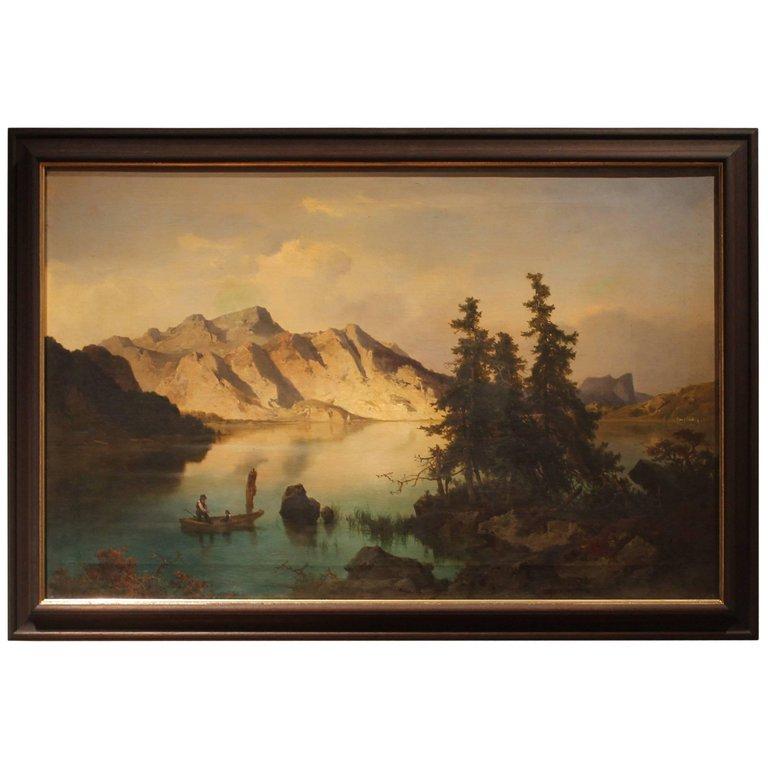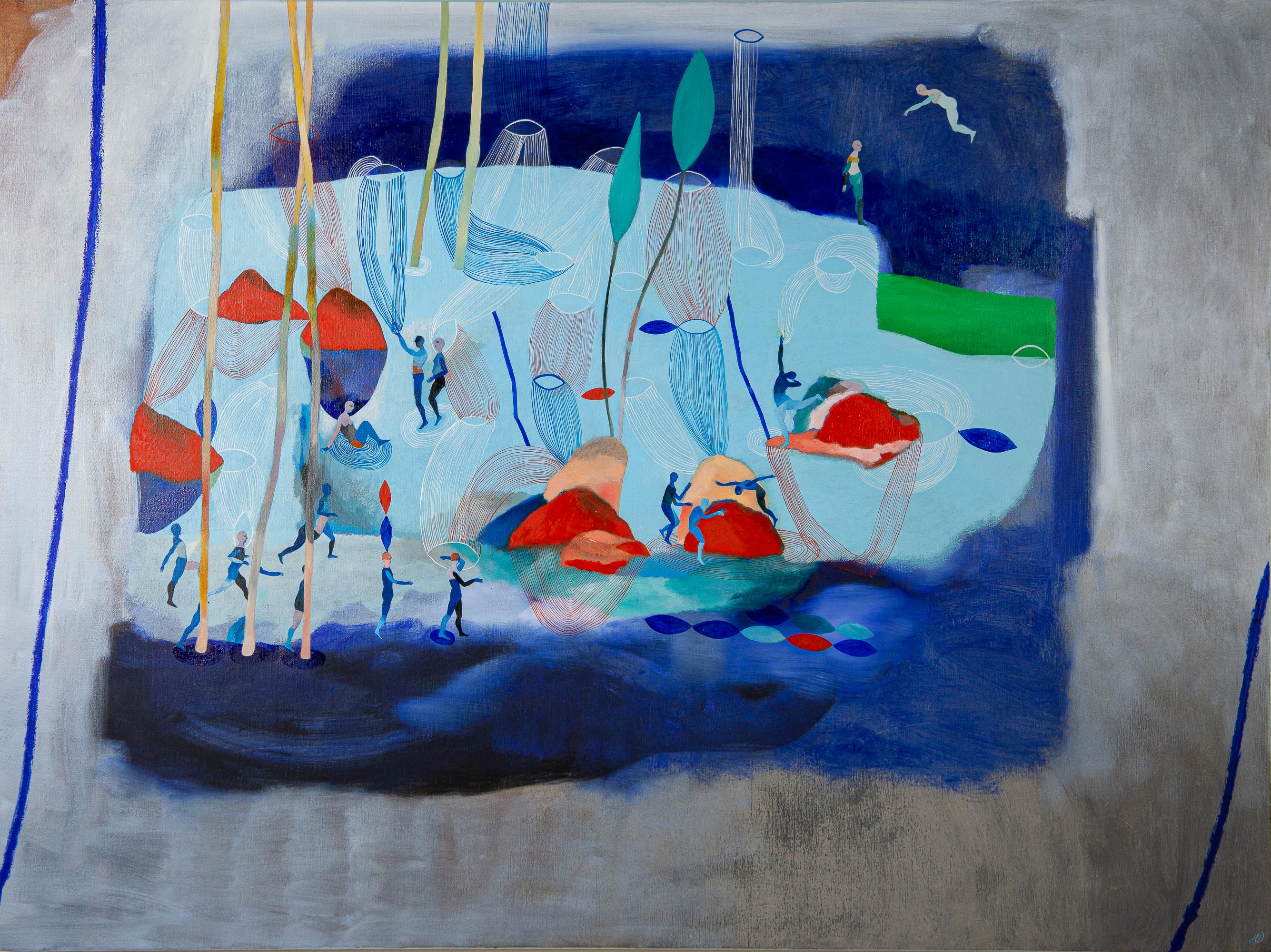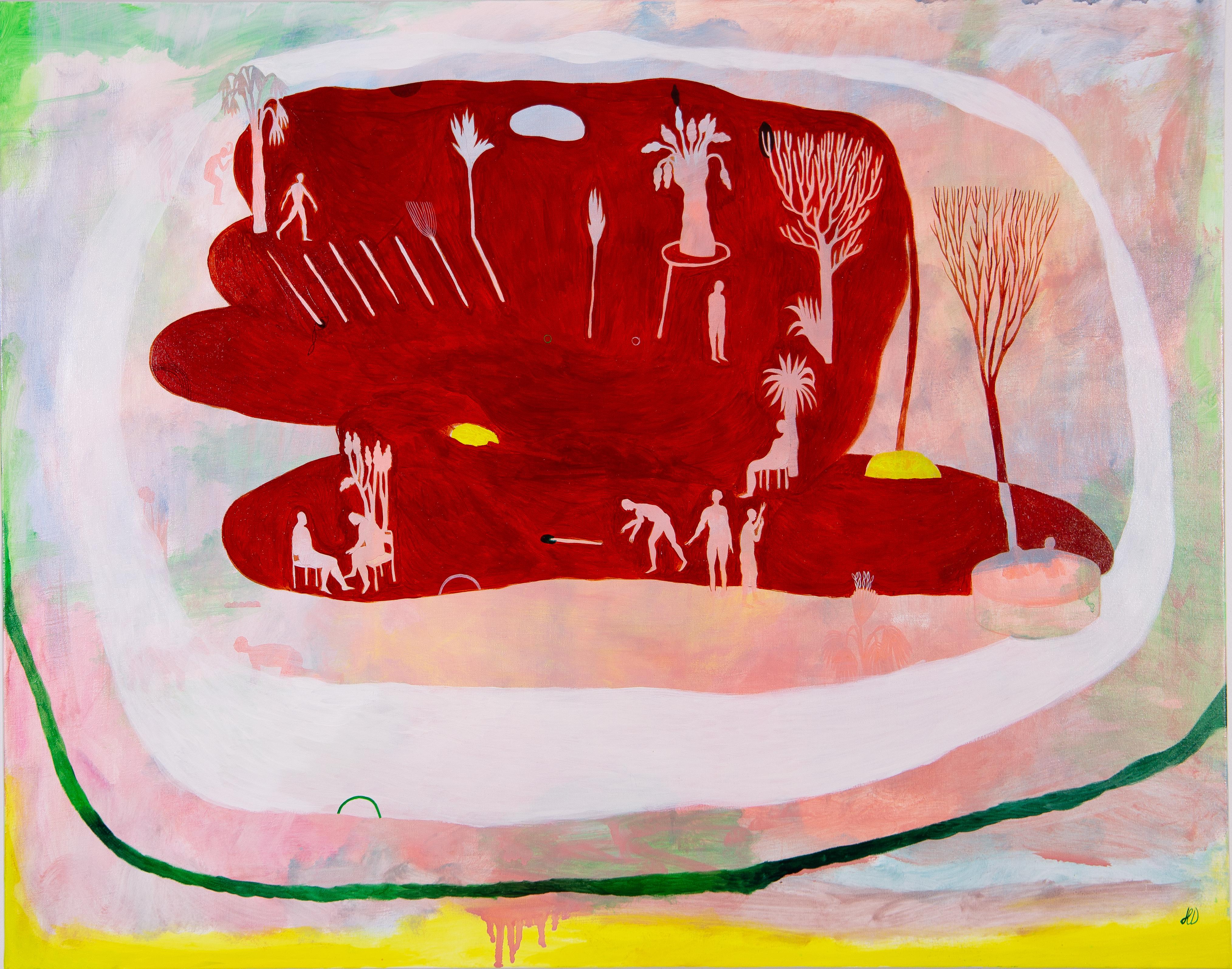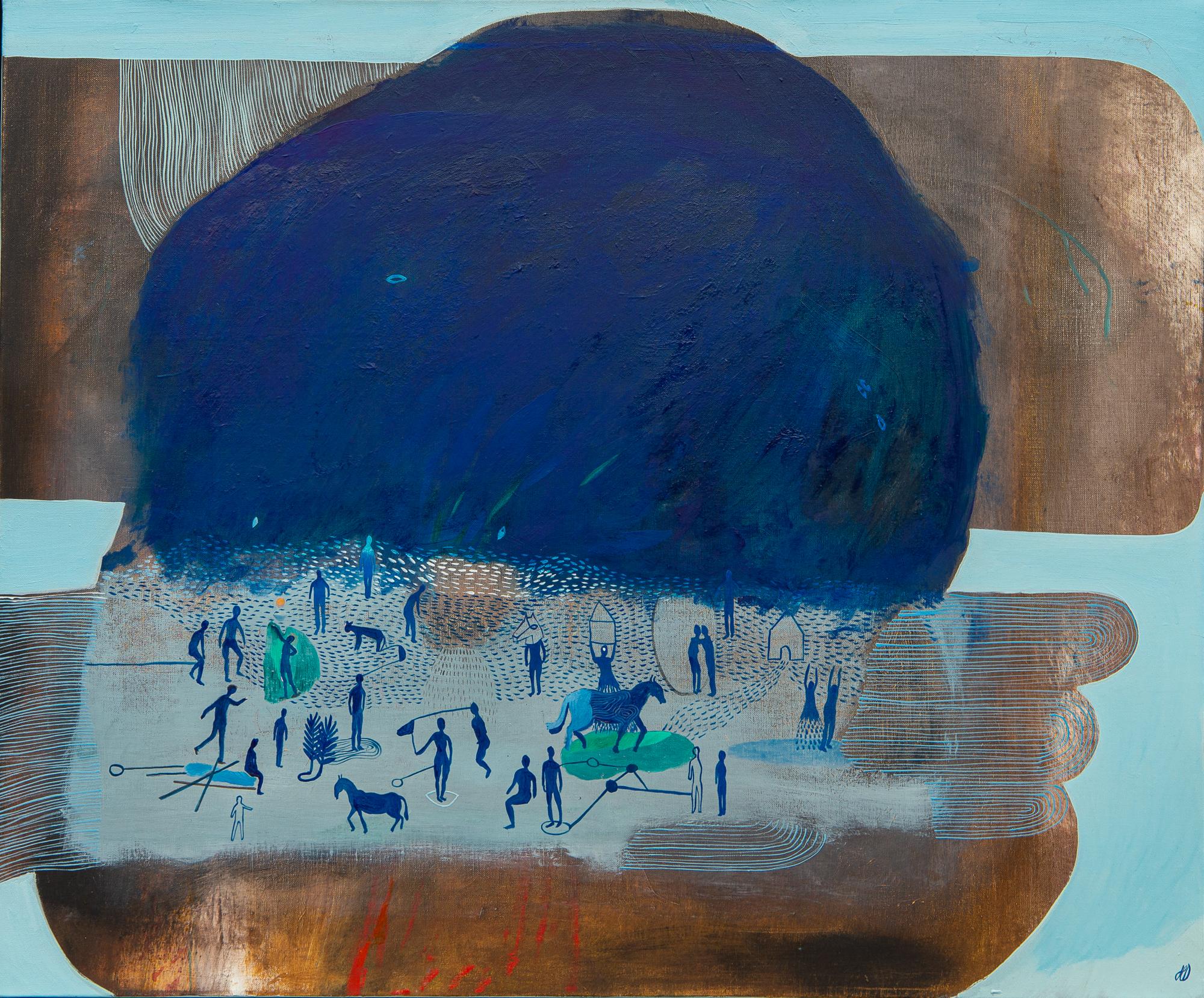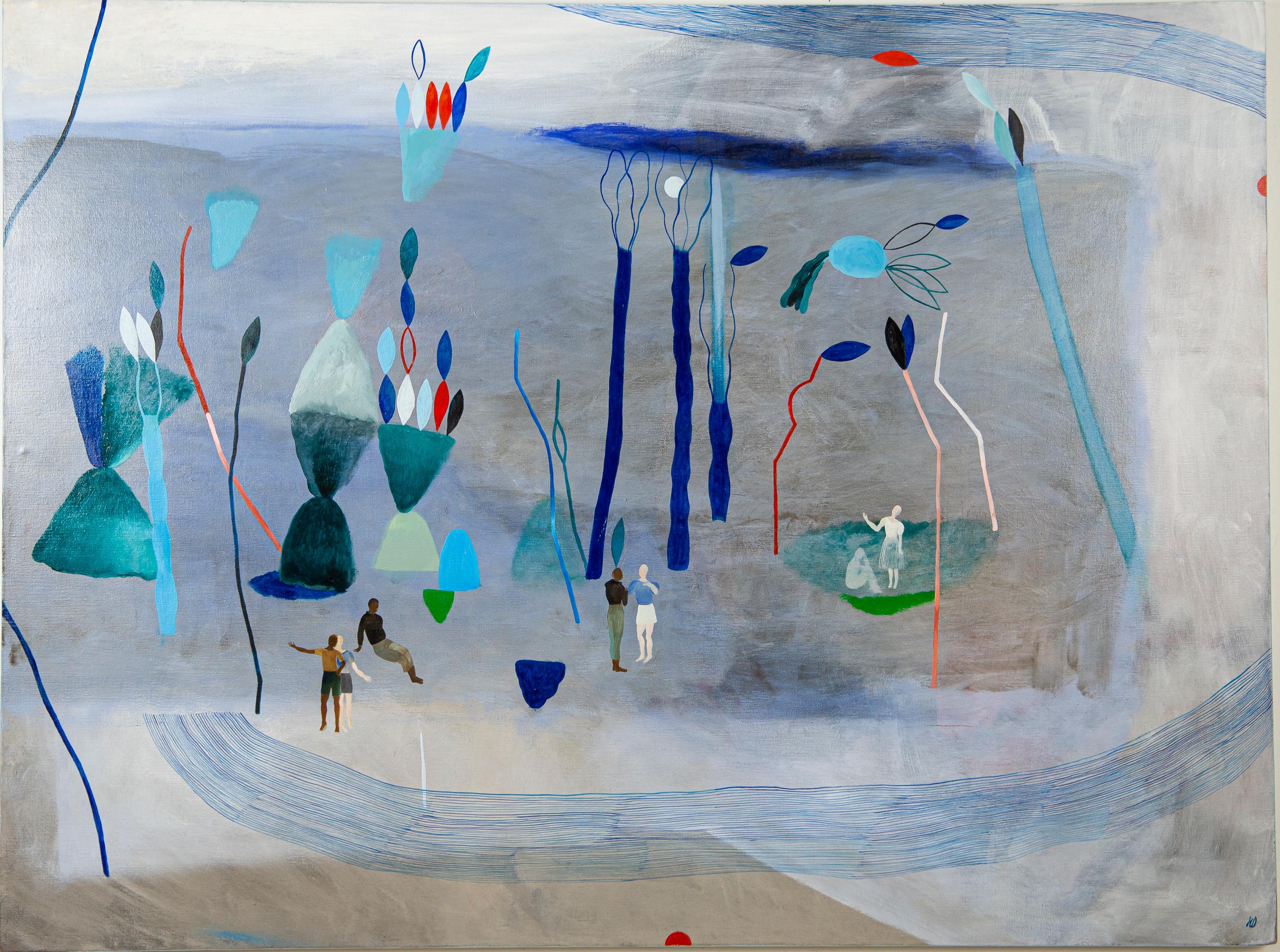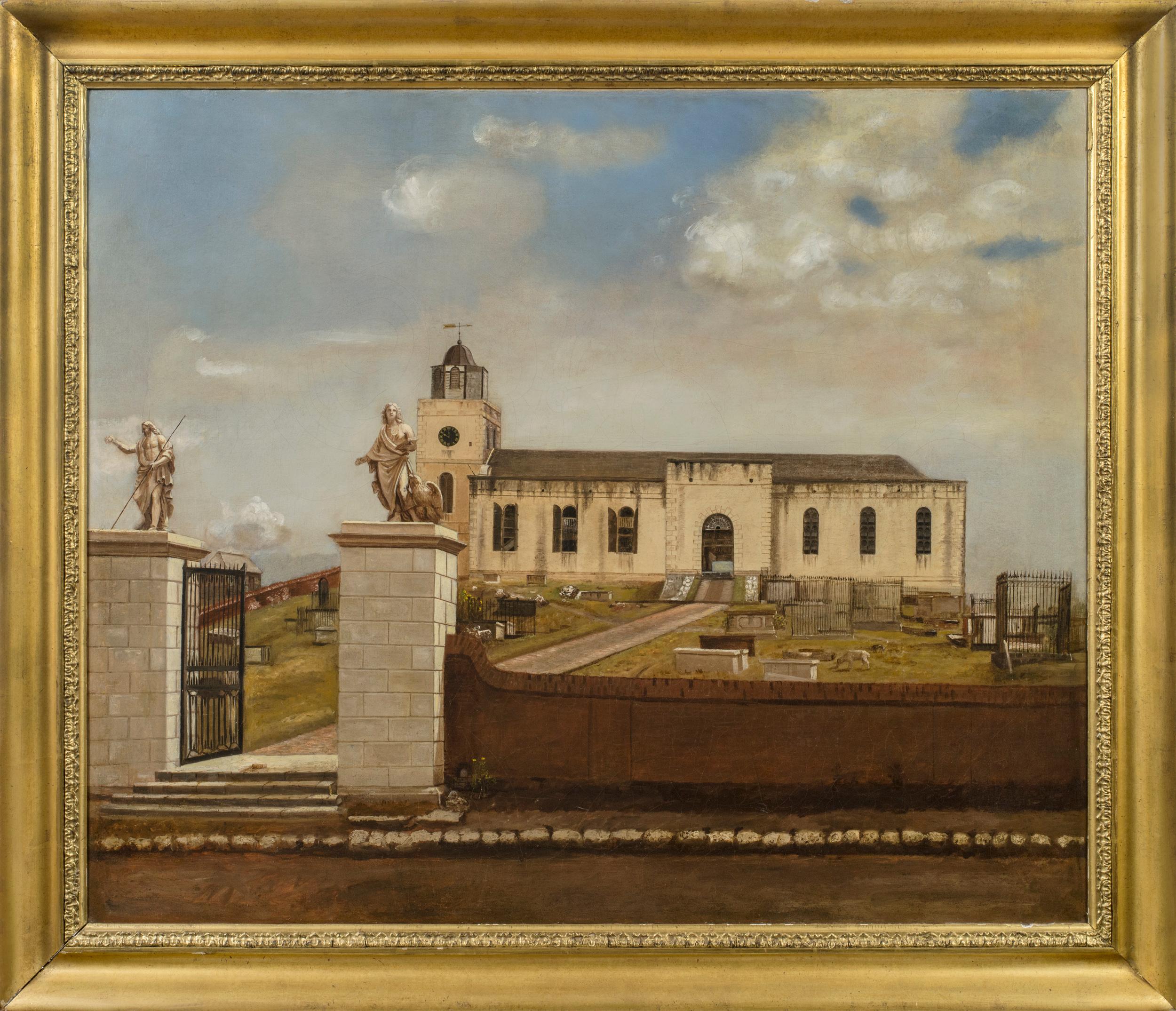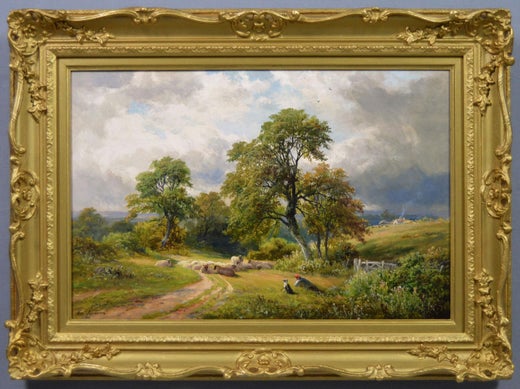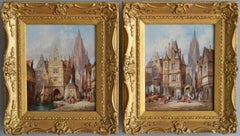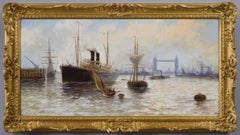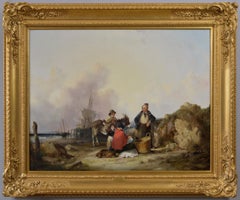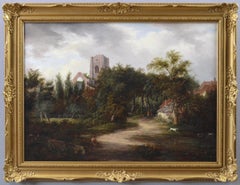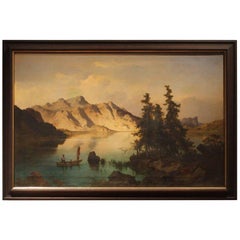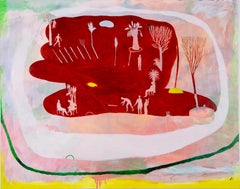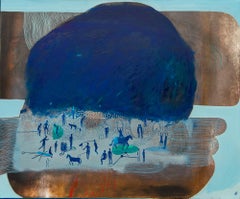Items Similar to 19th Century landscape oil painting of figures by a Derbyshire brook
Want more images or videos?
Request additional images or videos from the seller
1 of 17
George Turner19th Century landscape oil painting of figures by a Derbyshire brook1899
1899
About the Item
George Turner
British, (1843-1910)
A Derbyshire Brook
Oil on canvas, signed, further signed, titled & dated 1899 verso
Image size: 19.5 inches x 29.5 inches
Size including frame: 25.5 inches x 35.5 inches
Provenance: Cooling Galleries London; Fine Art of Oakham Ltd
A peaceful scene of figures with sheep resting near a brook in Derbyshire by George Turner. The shepherd can be seen fishing on the footbridge next to his companion who has been gathering wood. Turner was still living at Barrow-on-Trent at the time of this painting and would have been surrounded by picturesque views such as this. The location would most likely be somewhere he was familiar with, as the lane and the brook seem a little out of the way to come across by chance.
George Turner was a landscape painter born in Cromford, Derbyshire around 1843 to Thomas and Mary Turner. His father was a tailor and encouraged his son’s natural talent for art. Although largely self- taught, he was able to set himself up as a professional artist by the age of 20. He also turned his hand to private art teaching as a young man.
After moving to Barrow-on-Trent he met and married his first wife Eliza Lakin in 1865. They lived at her family farm ‘The Walnuts’ in Barrow-on-Trent and had four children, two of whom became artists, Mary Turner (later Woore) and the better known William Lakin Turner (1867-1936).
Turner specialised in rustic views and often painted scenes in South Derbyshire and the Trent Valley where he lived. He also visited Birmingham, North Wales and Scotland. He exhibited from 1860 at the Birmingham Society of Artists and Suffolk Street. He was a frequent exhibitor at the Derby Art Gallery and became a member of the Derby Corporation Art Gallery Committee. He continued teaching art throughout his life and became art master to Louis Bosworth Hurt (1856-1929), who lived in nearby Ashbourne and David Payne (1843-1894) who also lived in Barrow-on-Trent, as well as his son William.
In 1880, he was commissioned to paint views of Calk Abbey by Lady Crewe. After the death of his wife in 1900, he moved to Kirk Ireton, living for a time at the Barley Mow Inn and then at 81 Oxford Street, Derby. On 16 November, 1903, he married the artist Kate Stevens Smith (1871-1964) and moved to Cliffe Ash Cottage in Idridgehay. Turner died at Idridgehay on 29 March, 1910 and is buried in St James’ churchyard.
Turner has been dubbed ‘Derbyshire’s John Constable’ with his paintings being highly collectable. His work is held by a number of public collections including the Brampton Museum, Colchester & Ipswich Museums, Derby Museum & Art Gallery, Erewash Borough Council, National Library of Wales, National Trust, Russell-Cotes Art Gallery, Southampton City Art Gallery, Wigan Arts & Heritage Service and Wolverhampton Art Gallery.
Presentation: The painting is housed in a new, English made gilt frame which is in excellent condition. The reverse bears a label for the Cooling Galleries, an art dealership founded in 1903 and based at 150 Southampton Row, Fleet Street. The business moved to 92 New Bond Street in 1911, remaining there until the mid 1970’s. After relocating to 37 Albermarle Street, it later merged with Newman & Co to become Newman & Cooling. The gallery closed in April 1993. There is also a label for Fine Art of Oakham which operated out of 2A High Street, Oakham, Leicestershire during the early to late 1990’s.
Condition: As with all of our original antique oil paintings, this work is offered in ready to hang gallery condition, having been professionally cleaned, restored and revarnished.
© Benton Fine Art
- Creator:George Turner (1843 - 1910, British)
- Creation Year:1899
- Dimensions:Height: 25.5 in (64.77 cm)Width: 35.5 in (90.17 cm)Depth: 3 in (7.62 cm)
- Medium:
- Period:
- Condition:
- Gallery Location:Nr Broadway, GB
- Reference Number:1stDibs: LU15628667392
George Turner
During the 1880s and 90s, George Turner’s talents as a painter earned him a nationwide reputation as Derbyshire’s John Constable, and he became a teacher to several other notable painters of the time, including Louis Bosworth Hurt, David Bates, David Payne, and his son William Lakin Turner.
About the Seller
5.0
Platinum Seller
Premium sellers with a 4.7+ rating and 24-hour response times
Established in 1972
1stDibs seller since 2015
326 sales on 1stDibs
Typical response time: 1 hour
Associations
The British Antique Dealers' AssociationLAPADA - The Association of Arts & Antiques DealersInternational Confederation of Art and Antique Dealers' Associations
- ShippingRetrieving quote...Shipping from: Nr Broadway, United Kingdom
- Return Policy
Authenticity Guarantee
In the unlikely event there’s an issue with an item’s authenticity, contact us within 1 year for a full refund. DetailsMoney-Back Guarantee
If your item is not as described, is damaged in transit, or does not arrive, contact us within 7 days for a full refund. Details24-Hour Cancellation
You have a 24-hour grace period in which to reconsider your purchase, with no questions asked.Vetted Professional Sellers
Our world-class sellers must adhere to strict standards for service and quality, maintaining the integrity of our listings.Price-Match Guarantee
If you find that a seller listed the same item for a lower price elsewhere, we’ll match it.Trusted Global Delivery
Our best-in-class carrier network provides specialized shipping options worldwide, including custom delivery.More From This Seller
View All19th Century pair of French townscape oil paintings
By Henry Schafer
Located in Nr Broadway, Worcestershire
**PLEASE NOTE: EACH PAINTING INCLUDING THE FRAME MEASURES 15 INCHES x 13 INCHES**
Henry Schafer
German/British, (1841-c.1914)
Chartres, France & Metz, Lorraine
Oil on canvas, pair, both signed
Image size: 10 inches x 8 inches (each)
Size including frame: 15 inches x 13 inches (each)
Henry Schafer was born in Hanover, Germany in 1841. Although little is known about his upbringing, he was known to have studied at the l'Ecole National de Beaux-Arts in Paris. After leaving art school, he travelled throughout Europe painting town scenes and buildings of Northern France, Belgium and Germany. By 1864, Schafer had travelled to England with his wife Theresa, to work in London where they settled and started a family. All four of their children were born in England. One of his daughters Emilie Anna Schafer (1871-1937) became a painter and art teacher.
Around 1871, the family were living at 53 Vauxhall Bridge Road and in 1881 were recorded as residing at 6, Sophia Terrace, Beulah Road, Thornton Heath in Surrey, with Henry continuing to work as an artist. By 1891, he had moved to 7 St Peters Road in Islington where he lived for the rest of his life. Sometime around the turn of the century, he became a British subject. Schafer is believed to have died in London c1914.
Many of his works depict the architecture of gothic cathedrals and churches, as in these two fine examples. He also produced interior studies of churches. Schafer's style resembles that of Alfred Montague...
Category
19th Century Victorian Landscape Paintings
Materials
Canvas, Oil
Riverscape oil painting of shipping on the Thames near Tower Bridge & St Paul’s
By Edward Henry Eugene Fletcher
Located in Nr Broadway, Worcestershire
Edward Henry Eugene Fletcher
British, (1857-1945)
Shipping in the Pool of London with Tower Bridge & St Paul’s Beyond
Oil on canvas, signed
Image size: 14.25 inches x 29.25 inches
Size including frame: 19.25 inches x 34.25 inches
A wonderful painting of a steamship and other boats in the Pool of London by Edward Henry Eugene Fletcher. A two funnelled steamship is shown in the foreground next to sailing boats and a dock. Tower Bridge can be seen in the distance with St Paul’s Cathedral beyond. The Pool of London is a stretch of the River Thames between Tower Bridge and Limehouse and is divided into two sections, the Upper Pool and the Lower Pool.
Edward Henry Eugene Fletcher was a marine artist who was born in Marylebone, London on 23 July 1857 to Robert Henry Fletcher and Julia Pennell. His father worked for the Bengal Pilot Service guiding shipping along the Hooghly River between Calcutta and the Bay of Bengal. After the death of his father in 1862, his mother married the picture dealer Reuben Brooks. He attended the Bradmore House School in Chiswick Lane before enrolling at the Chelsea School of Art, where he became a close friend of the landscape artist Daniel Sherrin.
Fletcher initially enlisted in the Army Hospital Corp, serving in Nova Scotia but was invalided out in 1882 at the age of 24 due to an eye condition. His records indicate he was 6ft tall with fair hair and grey eyes. He continued to paint in his spare time and undoubtedly his travels would have inspired his subject matter and given him a deeper knowledge of shipping and the sea. He married Annie Reed Moses in 1886 at Norwich and they lived in Margate before moving back to London to live in Blackheath around 1890. He is widely believed to have set up an auction business during this time to help support his growing family, however , perhaps due to the return of ill health he decided to give it up to focus on painting.
Although he did not exhibit, he sold his work mainly through art galleries, possibly aided by his step father. He also used the pseudonym of John Hayes which was probably for contractual reasons. By 1901, he had established himself as a full time artist and was living at Georgette Place in Greenwich with his wife and their 5 children. He later moved to 99 Lee Road, Blackheath where he spent the rest of his life. He died at Blackheath on 23 June, 1945.
Much of Fletcher’s work consisted of views of the river Thames or ships in harbours...
Category
Late 19th Century Landscape Paintings
Materials
Canvas, Oil
19th Century genre oil painting of fisher folk on a beach
By WILLIAM SHAYER SENIOR (1787-1879)
Located in Nr Broadway, Worcestershire
William Shayer
British, (1787-1879)
Fisher Folk on the Beach
Oil on canvas, signed & dated 1839
Image size: 27.25 inches x 35.25 inches
Size including frame: 37.25 inches x 45.25 in...
Category
19th Century Victorian Figurative Paintings
Materials
Canvas, Oil
19th Century landscape oil painting of figures in a lane near Abbey ruins
By Edward Williams
Located in Nr Broadway, Worcestershire
Edward Williams
British, (1781-1855)
The Old Abbey Ruins
Oil on canvas
Image size: 22.25 inches x 30.75 inches
Size including frame: 28.25 inches x 36.75 in...
Category
19th Century Landscape Paintings
Materials
Canvas, Oil
19th Century landscape oil painting of hay making
By John Clayton Adams
Located in Nr Broadway, Worcestershire
John Clayton Adams
British, (1840-1906)
Hay Making
Oil on canvas, signed & indistinctly dated 187(5)?
Image size: 19.5 inches x 31.5 inches
Size including frame: 28.5 inches x 40.5 inches
Provenance: SA Spenser, 16b Grafton Street, Old Bond Street, London
A lovely landscape painting of hay...
Category
19th Century Landscape Paintings
Materials
Canvas, Oil
19th Century exhibition size landscape oil painting of Sheep on a cliff
By Charles Jones (b.1836)
Located in Nr Broadway, Worcestershire
Charles Jones
British, (1836-1892)
Sheep Resting
Oil on canvas, signed with monogram & dated 1877, further inscribed verso
Image size: 35 inches x 59 inches
Size including frame: 47 inches x 71 inches
Exhibition Size Painting
A fantastic exhibition sized landscape painting of sheep on a cliff top by the coast by Charles ‘Sheep’ Jones. At the time he produced this painting, Jones was living at Heathercroft, Balham Hill in London. Given the size and quality of the work it was most likely an exhibition piece. The topography and landscape suggest that this is the Dorset coast, one of his favourite places to paint.
Charles Jones was an animal painter who was born in Stepney, London in 1836. He was the son of the artist Samuel John Egbert Jones (1797-1861) and Dinah Jones. He lived with his parents and 9 siblings in Mile End and was a pupil of his father. In September 1859, he married Frances Rosalinda Downe, who was born in America. His son Arthur Bertram Loud (1863-1930) also became an artist. They lived at 12 Hayes Place, Lisson Grove from where he made his debut in London at the Royal Academy in 1861. He also exhibited at the British Institution, Suffolk Street, New Watercolour Society, Royal Institute of Oil Painters and the Royal Institute of Painters in Watercolours.
By 1867, he had become a successful artist and they had moved to 7 Paragon Place, Brixton Hill. From 1874 he lived at Heathercroft, Balham Hill where he spent the rest of his life. Jones became well known for specialising in paintings of sheep, cattle and deer in landscape settings. He spent his time travelling around visiting areas such as Devon, Dorset, Kent, Sussex and the Highlands. However, it is for his skilful painting of sheep that he is perhaps best known, and for which earned him the nickname of ‘Sheep’ Jones.
As well as the major London galleries, he also exhibited provincially at various locations including: the Royal Cambrian Academy where he was elected a member in 1886, the Glasgow Institute of Fine Arts, Manchester City Art Gallery, Royal Hibernian Academy, Royal Society of British Artists, Birmingham and the Walker Art Gallery, Liverpool. Some of the smaller more intimate galleries he exhibited at were Arthur Tooth & Sons and Thomas...
Category
19th Century Victorian Animal Paintings
Materials
Canvas, Oil
You May Also Like
J. Brunner 1869 Oil on Canvas Austrian Landscape with Lake and Mountain Painting
Located in Firenze, IT
This very fine quality 19th century oil on canvas in dark brown wood frame with gold leaves details throughout is signed by Joseph Brunner (Vienna 1826-...
Category
19th Century Romantic Landscape Paintings
Materials
Canvas, Wood, Oil
No extenuating circumstances #1 Hélène Duclos 21st Century Contemporary art blue
By Hélène Duclos
Located in Paris, FR
Oil and acrylic on canvas
Signed lower right
Unique work
1 / Hélène DUCLOS, 2016 – Artist Statement
“Questioning the human condition and the position of being alive – What is it to...
Category
21st Century and Contemporary Contemporary Landscape Paintings
Materials
Canvas, Oil, Acrylic
Look at things from distance #2 Hélène Duclos 21st Century Contemporary art red
By Hélène Duclos
Located in Paris, FR
Oil paint and acrylic paint on canvas
Signed lower right
Unique work
1 / Hélène DUCLOS, 2016 – Artist Statement
“Questioning the human condition and the position of being alive – W...
Category
21st Century and Contemporary Contemporary Landscape Paintings
Materials
Canvas, Oil, Acrylic
Take some fresh air #2 Hélène Duclos 21st Century painting Contemporary art blue
By Hélène Duclos
Located in Paris, FR
Oil paint on canvas
Signed lower right
Category
2010s Contemporary Figurative Paintings
Materials
Canvas, Oil
Do not retrace our steps #1 - Hélène Duclos, 21st Century, Contemporary art blue
By Hélène Duclos
Located in Paris, FR
Oil and acrylic on canvas
Signed lower right
Unique work
1 / Hélène DUCLOS, 2016 – Artist Statement
“Questioning the human condition and the position of being alive – What is it to...
Category
21st Century and Contemporary Contemporary Landscape Paintings
Materials
Canvas, Oil, Acrylic
View of St. John’s Cathedral, Antigua
Located in New York, NY
Provenance:
Robert Hollberton, Antigua, ca. 1841
Private Collection, New York
The present painting depicts Old St. John’s Cathedral on the island of Antigua. The church was erected in the 1720s on the designs of the architect Robert Cullen. It measured 130 feet by 50 feet with north and south porches 23 x 20 ½ feet. The tower, 50 feet high with its cupola, was added in 1789. The church was elevated to the status of a cathedral, but disaster struck in the form of an earthquake that destroyed the building on 8 February 1843. A memorandum of that date relates the event:
“On Wednesday, 8th February, 1843, this island was visited by a most terrific and destructive earthquake. At twenty minutes before eleven o’clock in the forenoon, while the bell was ringing for prayers, and the venerable Robert Holberton was in the vestry-room, awaiting the arrival of persons to have their marriage solemnized, before the commencement of the morning service, the whole edifice, from one end to the other, was suddenly and violently agitated. Every one within the church, after the first shock, was compelled to escape for his life. The tower was rent from the top to the bottom; the north dial of the clock precipitated to the ground with a dreadful crash; the east parapet wall of the tower thrown upon the roof of the church; almost the whole of the north-west wall by the north gallery fell out in a mass; the north-east wall was protruded beyond the perpendicular; the altar-piece, the public monument erected to the memory of lord Lavington, and the private monuments, hearing the names of Kelsick, Warner, Otley, and Atkinson, fell down piecemeal inside; a large portion of the top of the east wall fell, and the whole of the south-east wall was precipitated into the churchyard, carrying along with it two of the cast-iron windows, while the other six remained projecting from the walls in which they had been originally inserted; a large pile of heavy cut stones and masses of brick fell down at the south and at the north doors; seven of the large frontpipes of the organ were thrown out by the violence of the shock, and many of the metal and wooden pipes within displaced; the massive basin of the font was tossed from the pedestal on which it rested, and pitched upon the pavement beneath uninjured. Thus, within the space of three minutes, this church was reduced to a pile of crumbling ruins; the walls that were left standing being rent in every part, the main roof only remaining sound, being supported by the hard wood pillars.”
The entrance from the southern side into the cathedral, which was erected in 1789, included two imposing statues, one of Saint John the Divine and the other of Saint John the Baptist in flowing robes. It is said that these statues were confiscated by the British Navy from the French ship HMS Temple in Martinique waters in 1756 during the Seven Years’ War and moved to the church. The statues are still in situ and can be seen today, much as they appeared in Bisbee’s painting, but with the new cathedral in the background (Fig. 1).
Little is known of the career of Ezra Bisbee. He was born in Sag Harbor, New York in 1808 and appears to have had a career as a political cartoonist and a printmaker. His handsome Portrait of President Andrew Jackson is dated 1833, and several political lithographs...
Category
19th Century Old Masters Landscape Paintings
Materials
Canvas, Oil
Recently Viewed
View AllMore Ways To Browse
South Street Antiques
Mid Century Turner
Sheep Resting
Artist Russell Wood
Scottish Turner
1910s Still Life Paintings
Mans Cotes
Antique Fishing Collectables
Kirk Originals
William And Mary Antiques
Antique Farm Antiques Collectibles
Antique Barrow
S Kirk And Son
Hand Barrow
Sheep Shepherd Antique Oil Painting
Payne David
Kirk Bond
Resin Sculpture 1960s
